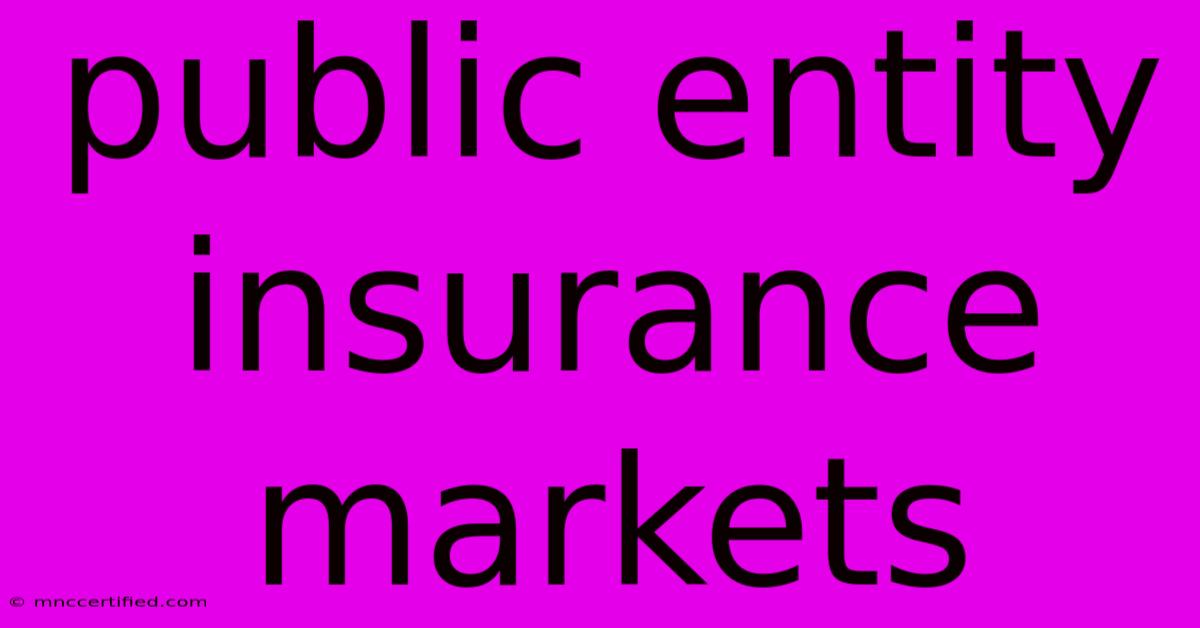Public Entity Insurance Markets

Table of Contents
Navigating the Complex World of Public Entity Insurance Markets
Public entities – encompassing government agencies, municipalities, school districts, and other public bodies – face unique insurance needs. Unlike private businesses, they often handle larger risks and operate under stricter regulations. Understanding the intricacies of the public entity insurance market is crucial for securing adequate coverage and managing financial risk effectively. This comprehensive guide delves into the key aspects of this specialized market.
Understanding the Unique Risks Faced by Public Entities
Public entities shoulder a diverse range of risks, often exceeding those of private sector organizations. These include:
- Liability Risks: These are potentially significant, encompassing claims arising from accidents on public property, negligent acts by employees, and violations of civil rights. Public liability insurance is paramount for mitigating these risks.
- Property Risks: Protecting public buildings, infrastructure, and assets from damage caused by fire, natural disasters, vandalism, or other perils is essential. Property insurance is vital in this context.
- Workers' Compensation: Public entities are legally obligated to provide workers' compensation coverage to their employees, protecting them in case of work-related injuries or illnesses.
- Cybersecurity Risks: With increasing reliance on technology, public entities face substantial cybersecurity risks, including data breaches and cyberattacks. Cyber liability insurance is becoming increasingly critical.
- Errors and Omissions (E&O) Insurance: This crucial coverage protects against claims arising from professional negligence or mistakes made by public officials or employees.
The Significance of Risk Management in the Public Sector
Effective risk management is not simply about purchasing insurance; it's a proactive approach that encompasses identifying, assessing, mitigating, and transferring risks. This includes implementing robust safety procedures, conducting regular risk assessments, and establishing clear policies and procedures. A strong risk management framework is crucial for minimizing claims and maintaining fiscal responsibility.
The Public Entity Insurance Market: Key Players and Structures
The public entity insurance market is diverse, featuring several key players:
- Commercial Insurers: Many traditional insurance companies offer specialized policies tailored to the needs of public entities. They provide a competitive market, offering various coverage options and pricing structures.
- Public Entity Risk Pools/Joint Powers Authorities (JPAs): These are cooperative organizations formed by multiple public entities to pool their risks and share insurance costs. They often offer lower premiums and greater control over coverage.
- State-Sponsored Programs: Some states operate their own insurance programs specifically designed for public entities within their jurisdiction. These programs can offer unique advantages, such as access to specialized expertise and potentially lower costs.
- Self-Insurance: Some larger public entities choose to self-insure, setting aside funds to cover potential losses. This approach requires careful financial planning and robust risk management capabilities.
Choosing the Right Insurance Provider: Factors to Consider
Selecting the right insurer or risk-sharing mechanism requires careful consideration of various factors, including:
- Coverage Limits: Ensure the policy limits are sufficient to cover potential losses.
- Premium Costs: Balance cost-effectiveness with the level of coverage needed.
- Claims Handling Process: Choose a provider with a proven track record of efficient and fair claims handling.
- Financial Stability: Select an insurer or risk pool with a strong financial rating.
- Customer Service: Effective communication and responsive customer service are critical.
Emerging Trends in Public Entity Insurance
The public entity insurance market is constantly evolving. Key trends include:
- Increased Cyber Risk: The growing threat of cyberattacks necessitates comprehensive cybersecurity insurance.
- Climate Change Impacts: The increasing frequency and severity of natural disasters are driving up insurance premiums and highlighting the need for robust disaster preparedness plans.
- Data Analytics and Risk Modeling: Insurers are leveraging data analytics to better assess and manage risks, potentially leading to more accurate pricing and improved risk mitigation strategies.
Conclusion: Securing a Stable Financial Future
Navigating the complexities of the public entity insurance market requires careful planning and a comprehensive understanding of the risks involved. By implementing effective risk management strategies and choosing appropriate insurance coverage, public entities can protect their assets, employees, and the public they serve, ensuring a stable financial future. Regular review and adaptation of insurance strategies are crucial to remain adequately protected in this dynamic environment.

Thank you for visiting our website wich cover about Public Entity Insurance Markets. We hope the information provided has been useful to you. Feel free to contact us if you have any questions or need further assistance. See you next time and dont miss to bookmark.
Featured Posts
-
Arsenals Win Aston Villas Loss Premier League
Nov 24, 2024
-
Insurance Companies Beaumont Tx
Nov 24, 2024
-
Major Title Insurance Companies
Nov 24, 2024
-
Car Insurance Cape Girardeau Mo
Nov 24, 2024
-
Arsenal 3 0 Victory Match Stats And Analysis
Nov 24, 2024